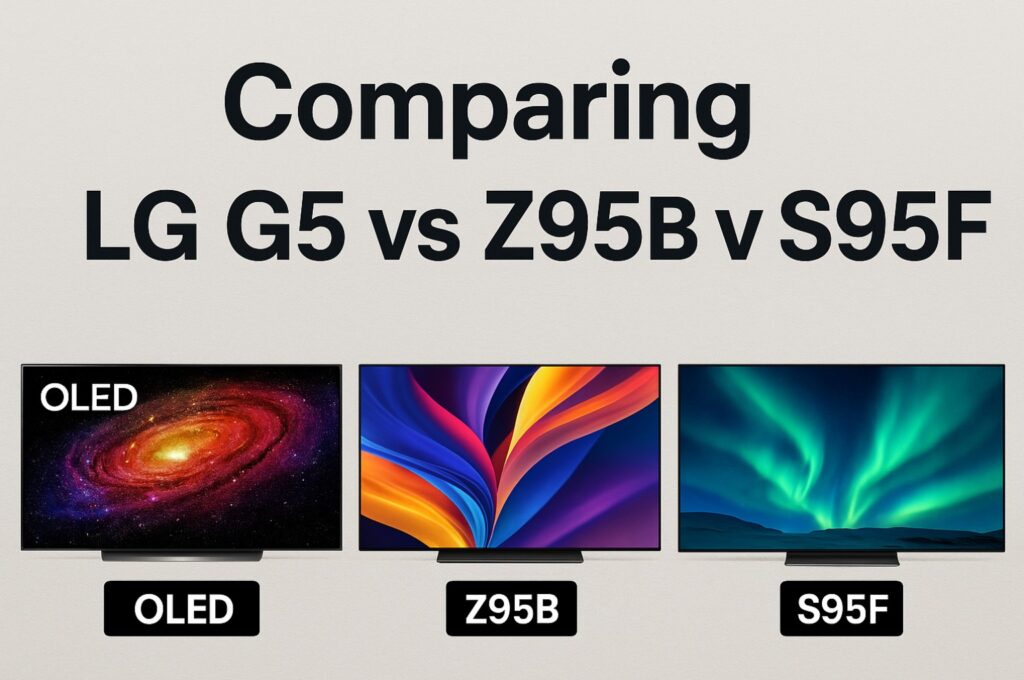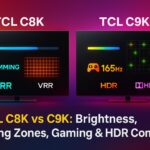LG G5 vs Samsung S95F vs Panasonic Z95B is the 65-inch showdown most buyers face: two Primary RGB Tandem OLEDs (LG G5 and Panasonic Z95B) versus Samsung’s QD-OLED S95F with a glare-killing matte finish. Below you’ll find verified specs, rounded brightness numbers (independent lab measurements) beside manufacturer claims, plus practical guidance for bright rooms, dark-room cinema, and gaming. 😎
Quick Takeaways for LG G5 vs Samsung S95F vs Panasonic Z95B
- Panel DNA defines the look: LG G5 and Panasonic Z95B use Primary RGB Tandem (four-stack) OLED; Samsung S95F is QD-OLED (pure RGB, no white subpixel) with matte anti-glare for daylight viewing.
- Cooling & sustain: Z95B adds ThermalFlow airflow cooling to sustain output and protect uniformity during long HDR sessions.
- High-Hz & ports: G5 and S95F go up to 4K165 with four HDMI 2.1; Z95B goes up to 4K144 with two HDMI 2.1 (four ports total).
65″ Comparison Table — Core Specs + Manufacturer Claims vs Measured (rounded)
| Category | LG G5 (65″) | Samsung S95F (65″) | Panasonic Z95B (65″) |
|---|---|---|---|
| Panel | Primary RGB Tandem (4-stack) OLED | QD-OLED (RGB), matte anti-glare | Primary RGB Tandem (4-stack) OLED + ThermalFlow cooling |
| Max refresh | Up to 4K165 | Up to 4K165 | Up to 4K144 |
| HDMI | 4× HDMI 2.1 (48 Gbps) | 4× HDMI 2.1 | 4× HDMI total (2× HDMI 2.1) |
| VRR / ALLM | HDMI Forum VRR, FreeSync, G-SYNC compat.; ALLM | HDMI Forum VRR, FreeSync; ALLM | HDMI Forum VRR, FreeSync; ALLM |
| HDR formats | HDR10, HLG, Dolby Vision | HDR10, HLG, HDR10+ (no DV) | HDR10, HLG, Dolby Vision (IQ), HDR10+ |
| Manufacturer HDR claim | No hard nits published; LG claims ~45% brighter vs G4 with Brightness Booster Ultimate | No hard nits published; focus on OLED Glare-Free & “outstanding brightness” | No hard nits published; Primary RGB Tandem + ThermalFlow marketed as delivering extraordinary brightness |
| Measured HDR peak (10% window) | ≈ 2,450 nits | ≈ 2,300 nits | ≈ 2,400 nits |
| Measured SDR real-scene (peak) | ≈ 800 nits | ≈ 700 nits | ≈ 500 nits |
| Notable | 4×48 Gbps; clean HGIG workflow | Matte screen excels in daylight; high color luminance | Tandem + ThermalFlow sustain output; DV + HDR10+ flexibility |
Notes: “Measured” figures are rounded from reputable independent lab testing in accurate picture modes; exact results vary by firmware/panel sample. Manufacturers often state relative gains (e.g., “X% brighter”) instead of hard-nits on product pages—hence the two-line comparison. 👍
Design & Build Quality
- LG G5: Gallery-style chassis for flush wall-mounting, tidy cable routing, and four 48 Gbps HDMI that simplify multi-device setups.
- Samsung S95F: Sleek pedestal-friendly design and that matte QD-OLED surface which tames reflections—ideal if you have windows or bright lamps near the screen.
- Panasonic Z95B: Purposeful, slightly more substantial body—by design—for ThermalFlow airflow; cinema-centric tuning with a robust, Technics-influenced speaker array in some regions. ✨
Panel Technology Explained
Primary RGB Tandem (LG G5 & Panasonic Z95B)
A four-emitter OLED stack boosts luminous efficiency and color purity vs older WOLED designs. At 65″, both G5 and Z95B use Primary RGB Tandem; Z95B pairs it with ThermalFlow to keep output stable in long HDR scenes. Result: bright, controlled highlights and unusually strong sustained luminance for real content. 🧠
QD-OLED (Samsung S95F)
Blue OLED emitters + quantum dots yield pure RGB subpixels (no white subpixel), helping bright colors stay saturated at high nits. The matte finish slashes mirror-like reflections and keeps perceived contrast alive in daylight; the trade-off is no Dolby Vision (HDR10/HDR10+ instead).
Brightness & HDR Performance (65″, rounded values)
- LG G5: ~2,450 nits (10% HDR) and ~800 nits SDR real-scene in accurate modes. Highlights are punchy yet controlled; sustain is excellent—great for HDR films and mixed-light viewing. Dolby Vision keeps streaming and UHD Blu-ray consistent. ✨
- Samsung S95F: ~2,100 nits (10% HDR) and ~700 nits SDR real-scene. QD-OLED color luminance plus matte anti-glare yields confident daytime HDR. You’ll rely on HDR10/HDR10+ (no DV).
- Panasonic Z95B: ~2,400 nits (10% HDR) and ~500 nits SDR real-scene in calibrated profiles. ThermalFlow helps maintain output; tone-mapping is restrained and near-black is nuanced. DV + HDR10+ offers format flexibility. 🎬
Color Accuracy & Picture Processing
- Z95B ships reference-leaning (Filmmaker/Professional). Gradations are clean; HDR tracking is conservative rather than showy.
- G5 in Filmmaker/Cinema is easy to dial in; Dynamic Tone Mapping can add pop if you prefer it.
- S95F balances improved Filmmaker/Movie accuracy with QD-OLED’s inherently vivid color volume; the matte surface keeps reflections at bay by day.
Motion Handling & Refresh Rates
All three are 120 Hz native with ultra-fast pixel response. For PC/competitive play: G5/S95F reach 165 Hz, Z95B reaches 144 Hz (availability depends on resolution/port). For films, keep interpolation low to avoid soap-opera artifacts. ⚽
Gaming Performance
- LG G5: 4× HDMI 2.1 (48 Gbps), 4K165, full VRR (HDMI Forum + vendor variants), Game Optimizer, and a clean HGIG workflow. Step-by-step: HGIG gaming settings for PS5/Xbox. 🎮
- Samsung S95F: 4K165, ultra-low input lag, Gaming Hub, and broad VRR. Lack of Dolby Vision Gaming is the main omission; HDR10/HDR10+ are tuned well.
- Panasonic Z95B: 4K144 with 2× HDMI 2.1, True Game mode tuned for accuracy, low lag, clean gradations—ideal for story-driven titles.
If VRR triggers near-black flicker in specific games, these mitigations help: Fix VRR Flicker on TV. 😉
Smart Platform & UX
- webOS (G5): fast app access, Game Optimizer overlay, clear picture controls.
- Tizen (S95F): huge app library and Gaming Hub; menus are deeper/denser in places.
- Fire TV / My Home Screen (Z95B, region-dependent): app-rich and clean; you may want to minimize ad surfaces in settings.
Audio & Connectivity
- Ports: G5 offers the simplest high-bandwidth layout (4× 48 Gbps). S95F also has four HDMI 2.1 (eARC on one). Z95B provides two HDMI 2.1 + two HDMI 2.0—plan port usage if you run multiple 4K120/144/165 sources and eARC.
- Audio: Z95B includes a robust, Technics-influenced array; S95F carries a multi-speaker setup; all pass Dolby Atmos over eARC (DTS passthrough varies by brand/region—check manuals). 🔊
Port-by-Port I/O Maps (Typical 65″ layouts)
Exact numbering can vary slightly by region/HW revision; check on-screen labels. The eARC port is shown below as typically implemented.
LG G5 (65″)
- HDMI 1: 48 Gbps (4K120/144/165, VRR)
- HDMI 2 (eARC): 48 Gbps (use for soundbar/AVR)
- HDMI 3: 48 Gbps (4K120/144/165, VRR)
- HDMI 4: 48 Gbps (4K120/144/165, VRR)
- USB x2, Optical, Ethernet, Antenna
Samsung S95F (65″)
- HDMI 1: HDMI 2.1 (high-bandwidth)
- HDMI 2: HDMI 2.1 (high-bandwidth)
- HDMI 3 (eARC): HDMI 2.1 (connect soundbar/AVR here)
- HDMI 4: HDMI 2.1 (high-bandwidth)
- USB x2/3, Optical, Ethernet, Antenna
(One-Connect availability depends on region; if present, ports are on the box.)
Panasonic Z95B (65″)
- HDMI 1: HDMI 2.0 (up to 4K60)
- HDMI 2 (eARC): HDMI 2.1 (allocate to soundbar/AVR or 4K120 source)
- HDMI 3: HDMI 2.1 (4K120/144 capable)
- HDMI 4: HDMI 2.0 (up to 4K60)
- USB x2, Optical, Ethernet, Antenna
Quick Calibration Cards (fast, safe, accurate)
Menu paths can vary by model/region. Use Filmmaker/Movie/Professional for films; Game Mode for gaming. Keep motion smoothing low for cinema. 🧩
LG G5 — Film (dark room)
- Picture Mode: Filmmaker
- OLED Pixel Brightness: 65–80 (room-dependent)
- Contrast: 100 | Peak Brightness: High
- Color Temp: Warm 50 | Color: 50
- Dynamic Tone Mapping: Off (or HGIG for console movies)
- TruMotion: Off / De-Judder 0 / De-Blur 0
LG G5 — Game (PS5/Xbox/PC)
- Picture Mode: Game Optimizer
- VRR: On | HGIG: On → run console HDR calibration
- Black Stabilizer: 0 to +5 (taste; avoid crushing)
- Peak Brightness: High | DTM: Off/HGIG
- If VRR flicker appears: see Fix VRR Flicker on TV
Samsung S95F — Film (dark room)
- Picture Mode: Movie / Filmmaker
- Contrast Enhancer: Off | ST.2084: 0 | Shadow Detail: 0
- Color Tone: Warm 2 | Color Space: Auto
- Peak Brightness: High (default in HDR)
- Motion: Off or minimal blur reduction
Samsung S95F — Game
- Game Mode: On (Auto)
- VRR: On | Game HDR: Basic/On (avoid overshoot)
- Color Tone: Warm 2 | Shadow Detail: 0 to +1
- If text fringing on PC: try 4:4:4 / PC mode and font smoothing
Panasonic Z95B — Film (dark room)
- Picture Mode: Filmmaker / Professional 1
- HDR Tone Mapping: Accurate/Static (avoid artificial boost)
- Color Temp: Warm | Noise Reduction: Off
- Motion: Off or minimal interpolation
Panasonic Z95B — Game
- Picture Mode: True Game
- VRR: On | HDR: On
- Sharpness: 0–10 (avoid halos)
- For PC 4K144: ensure HDMI 2 or 3 (2.1 ports) and proper GPU timing
Smart Platform & UX
- webOS (G5): fast app access, Game Optimizer overlay, clear picture controls.
- Tizen (S95F): large app library and Gaming Hub; menus are deeper/denser in places.
- Fire TV / My Home Screen (Z95B): clean and app-rich; minimize ad surfaces in settings if you prefer a quieter UI.
Thermal Design & Longevity
Z95B’s ThermalFlow uses a re-engineered airflow path to dissipate heat, helping sustain brightness and protect panel health during long HDR sessions. G5 and S95F rely on panel-care/firmware safeguards (pixel shift, logo dimming, compensation cycles). Use them—and avoid marathon static HUDs at max brightness. 🔧
Real-World Impressions
- Bright rooms / daytime sports & gaming: Samsung S95F feels tailor-made—matte anti-glare plus strong QD-OLED peaks equals confident daytime performance. LG G5 runs a close second on punch thanks to its tandem stack. 😍
- Dark-room cinema, reference tone-mapping: Panasonic Z95B stands out for near-black discipline and conservative mapping, with Dolby Vision & HDR10+ for format flexibility.
- Balanced “do-everything” buyer: LG G5 combines top-tier brightness, Dolby Vision, and four 48 Gbps HDMI for painless multi-device setups and PC gaming at 4K165. ✨
Common Mistakes to Avoid
- Using Vivid for movies—great in showrooms, inaccurate at home. Prefer Filmmaker/Cinema/Movie.
- Skipping HGIG on consoles—enable HGIG (where available) and run the console’s HDR calibration.
- Maxing motion smoothing—keep interpolation low for films.
- Not planning ports on Z95B—with only 2× HDMI 2.1, decide early which source gets eARC vs 120/144/165 Hz.
- If VRR flicker appears, use: Fix VRR Flicker on TV. 😉
FAQ
Q: Which one should I pick — LG G5 vs Samsung S95F vs Panasonic Z95B — for a bright living room?
A: Samsung S95F. The matte QD-OLED surface kills reflections while keeping highlights punchy. LG G5 is close on peak output but lacks the same glare suppression.
Q: Are the 65″ LG G5 and Panasonic Z95B truly Primary RGB Tandem?
A: Yes. Both use Primary RGB Tandem (four-stack) OLED at 65″; Z95B pairs it with ThermalFlow cooling for stability.
Q: How bright do they actually get in HDR?
A: Rounded independent-lab figures at 65″: G5 ≈ 2,450 nits, S95F ≈ 2,100 nits, Z95B ≈ 2,400 nits (10% window). Real-scene results vary by mode and tone-mapping.
Q: Do all ports support 48 Gbps?
A: G5: yes, 4× 48 Gbps. S95F: four HDMI 2.1 (bandwidth/features vary by port, but 4K165 is supported). Z95B: 2× HDMI 2.1 + 2× HDMI 2.0.
Q: Does the matte screen on S95F hurt contrast at night?
A: In a pitch-black room some viewers prefer glossy blacks, but in real homes the matte treatment often improves perceived contrast by cutting reflections.
Final Verdict
- Choose Samsung S95F if you watch a lot in daylight and hate reflections—matte QD-OLED plus strong peaks delivers the most comfortable daytime HDR.
- Choose LG G5 if you want the most well-rounded package: Primary RGB Tandem, Dolby Vision, four 48 Gbps HDMI, and 4K165 for PC.
- Choose Panasonic Z95B if you’re cinema-first and want reference-leaning tone-mapping with both Dolby Vision and HDR10+, backed by ThermalFlow to sustain output in long HDR sessions.
Whichever you pick, spend five minutes selecting the right picture mode and run your console HDR setup—you’ll unlock most of what these panels can do. 🎬🎮


